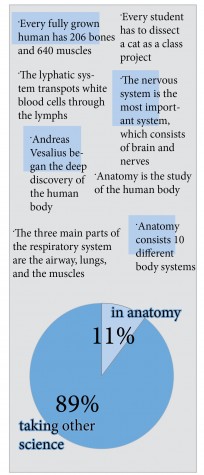Science in context
Insight on Blue Valley’s science department
Anatomy is the study of the body, and it is also a course here at Blue Valley for sophomores and juniors. There are 176 students currently take the class; one of them is junior Hannah Kelly.
“I would like to grasp a future understanding of every part of the human body and even more than just humans,” Kelly said. “I’m definitely looking forward to the cat dissection and just a further understanding of how thing work.”
The cat dissection is a long project that all anatomy students take on. It is a real representation of how all of the body system works. Anatomy teacher Jena Kline said she doesn’t want the students to maim and dismember the cats because they have given us their lives for us to study them, and so we want to be respectful.
“I love dissecting,” Kline said. “I love seeing the kids getting so excited about it.”
BV has won the Standard of Excellence in science aw arded by Blue Valley school as stated in their website.
arded by Blue Valley school as stated in their website.
Kline said the students this year have been doing well so far — they are quiet but good students. She said there is also new technology advancements for the teachers.
“I think the biggest thing for science this year that we see is that we have Ipad carts,” Kline said. “I love my smartboard. That’s probably my most favorite thing I’ve gotten in the past nine years.”
One of the anatomy teachers is Larry Hare. Kelly says her favorite part of anatomy is Hare’s discussions he has on the side.
“I just like how they all seem to care…about their students’ well-being.” Kelly said. “They seem very interested also in what they are doing.”
Kline said she has many expectations for the anatomy students this year. She wants her students to not only respect each other but the organisms they work with.
I think probably the biggest one is that they are ready to learn. That they are here- they have to be here and that’s understandable- but especially for anatomy that they are excited to be here and they are ready to learn. Kline said. “They’re very similar to how they are laid out in humans so knowing our body looks on the inside, that’s powerful.”



